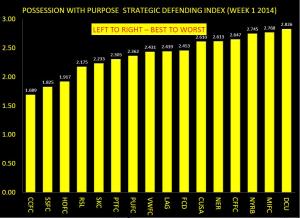2015 ASA Preview: DC United
/*xG = expected goals, xA = expected assists, xGD = expected goal differential. For more information see our xGoals by Team page.
By Jared Young (@jaredeyoung)
Time for soccer analysts to perk up because D.C. United’s 2015 season is the one to watch if you are into numbers. Why? Because in 2014, D. C. United defied them. And the story of the year, at least for the geeks, is whether or not D.C. United can do it again.
After one of the worst seasons in franchise history in 2013, D.C. United shocked the league and won the Eastern Conference in 2014. A turnaround like that required improvement on both sides of the ball. United went from easily the worst offense in the league with 22 goals to a solid offense with 52. And they turned the worst defense in the league with 59 goals allowed to tied for the league’s best with 37 goals.
So what’s the problem? The issue is that the numbers say it shouldn't have happened. The ASA expected goals model says that D.C. United should have scored just 38 goals compared to their 52. And on the defensive side the ASA models thinks that 48.6 goals against would have been a more likely number, compared to the actual 37. Their expected goal ratio in fact was 3rd worst in MLS. Michael’s Caley’s expected goals model suggests a similar story to that of ASA. Were D.C. United just lucky or are they doing something that the models don’t contemplate? On the offensive side of the equation the positive story can be traced to two dynamics scorers.
D.C. United’s dynamic duo
If United fans had their way, they’d pair Luis Silva and Fabian Espindola at the top of Ben Olsen’s 4-4-2 formation. And despite the fact that the two play a very similar style of forward, they’d be right. That pair was the reason for the strong shooting from United. The paid scored 22 goals last season, but the ASA expected goals model suggest they should have 11.4. That 10+ goal gap is most of the team’s “overproduction” last year.
Espindola’s finishing prowess is puzzling because he actually took his shots on average four feet further from the goal than other shooters. Remarkably he was terrific at avoiding blocked shots. While shooters on average have their shots blocked one in every four attempts, Espindola had that happen approximately once in almost eight attempts. He may have been more focused on getting open looks versus how far he was from the goal. Silva’s ability is tougher to figure. Everything but his finishing rate appears average. His shots on target level was slightly higher than average and the percentage of his shots that were blocked was 23 percent. Unless the team finds new ways to increase their shot totals, the duo’s ability to shoot better than expected will be depended on going into 2015.
What’s changed going into the 2015 season?
The biggest change for the red and black this offseason was actually confirmation of a new soccer specific stadium to be built for the 2017 season. That stadium has the opportunity to enhance the soccer experience in the D.C. area and build a bigger base of fans for the team.
From a roster perspective there were just a few changes. United added Jairo Arrieta from Columbus Crew as forward depth. He will be a key contributor, especially in the early going. The most intriguing acquisition was nearly 31 year old Malmo FF and Finnish national midfielder Markus Halsti. Halsti is a versatile defensive minded midfielder who also adds depth for the defense. He should fit in well with Perry Kitchen, Davey Arnaud, Nick DeLeon and Chris Pontius. D.C. United also signed their first round pick Miguel Aguilar, who figures to get his feet wet on the wings this season.
No change is good news for the defense that led the league is goals against. Second year emerging star Steve Birnbaum and Bobby Boswell anchor the center of the defense while Sean Franklin, Taylor Kemp, and Chris Korb will rotate at the fullback.
What to expect in 2015
When expected goals models fail how can you expect what to expect? The defense-first United stand to keep up their stingy ways despite the models. The return of the core defense and the continued development of one of the bright young keepers in MLS, Bill Hamid, should mean Ben Olsen’s squad maintains their perch near the top of MLS.
The offense could prove to be more difficult to maintain, at least to start the season. Espindola starts the campaign with a six game suspension and Silva has been nursing a hamstring all preseason. Eddie Johnson’s playing future is uncertain at this point due to an enlarged heart, and that leaves Chris Rolfe and Arrieta to maintain status quo. It could be a rocky opening to the season, but one of United’s strengths is that they have a number of players that can play multiple positions. Rolfe and Pontius, for example, are hybrid offensive players that give Olsen flexibility with both lineups and styles of play.
And therein lies United’s core strength; while they prefer to play defense first and are usually more reactive than their competition, they can win playing all styles. Early on Ben Olsen will need to mix and match players until he lands on a core group and formation. There’s no reason to think that D.C. United will slip so far as to miss the playoffs, unless of course you believe that numbers never lie.













